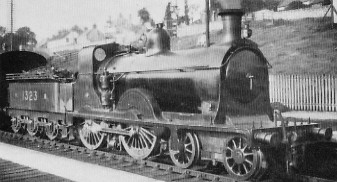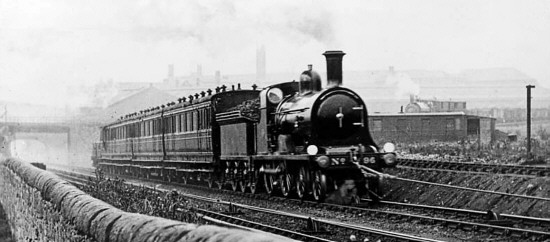The Drummond D27 & D28 (NBR Class M) 'Abbotsford' 4-4-0 Locomotives

A Midland Railway through service over the Waverley route to Edinburgh was introduced in May 1876. The existing Wheatley 4-4-0s were not powerful enough for this service, so Drummond designed his Class M locomotives as replacements. Due to the urgency involved, the first four locomotives partially replaced an existing order for J32 0-6-0s. A total of twelve Class M engines were built in three batches between 1877 and 1879. Neilson & Co built the first two batches, and Cowlairs built the last. The class became known as the 'Abbotsford' Class, probably due to the use of No. 429 Abbotsford on the official Neilson photograph.
The 'Abbotsfords' were a significant milestone for both the North British Railway (NBR) and Drummond. For the NBR, these locomotives set out the basic 4-4-0 design from which all future NBR 4-4-0s would be developed. As a student of Stroudley, Drummond had followed Stroudley's design principles to the letter, and the 'Abbotsfords' represented a significant break away from these principles. The 'Abbotsfords' were also very large compared to contemporary locomotives, and it would be almost twenty years before any British design would significantly exceed them in size. As well as influencing all future NBR 4-4-0s, the 'Abbotsfords' had a clear impact on later designs from the Caledonian, Glasgow & South Western, and London & North Western Railways.
Official records show that No. 476 was rebuilt in 1888, but there is no evidence of any alteration other than the fitting of a new boiler, recognisable by a manhole cover on the whistle opening.

The heating surface parameters were also modified before the 1902/4 rebuilds. The exact reasons are not recorded, but it is thought that Holmes renewed some of the fireboxes and/or tube plates. Other modifications during this period include the replacement of Ramsbottom safety valves with 3in lock up valves. Outward-opening wooden cab doors were also fitted.
Following NBR practice, the 'Abbotsfords' were rebuilt in 1902 and 1904 as their original boilers required replacement. These rebuilds included larger boilers that helped to bring them back to main line passenger standards. The six that were rebuilt in 1902 had Holmes round cabs fitted, but retained their wooden doors. The remaining six were rebuilt in 1904 with single side-window cabs and modern inward-folding doors. The LNER felt that this difference warranted two different classes, and classed the 1902 batch as Class D27, and the 1904 batch as Class D28. The D28s were slightly heavier, but otherwise the two classes were very similar. The rebuilds resulted in both the D27s and D28s resembling the Holmes Class M (LNER D31), with the exception of small details such as the front of the smokebox and the exact shape of the frames.

The 'Abbotsfords' were built to haul the through Midland expresses over the Waverley route, and all but two were initially allocated to this duty. The ten engines were shared between St. Margaret's and Carlisle, and contemporary accounts describe their work as being of a very high standard. This 98 mile stretch with a number of steep gradients was scheduled at 2hrs 20mins non-stop, and 2hrs 35mins with three intermediate stops. Loadings were typically 120 tons, and coal consumption was recorded as 28 lb/mile.
The two exceptions were allocated to Aberdeen, and operated the Aberdeen to Burntisland services. The Tay Bridge Disaster of 1879 led to the cessation of this service, and both engines were moved to the Waverley route.
The introduction of the Holmes D31s in the 1890s, led to the 'Abbotsfords' being used on a wider range of routes, although they continued to be used on express passenger services. Typical duties in about 1900 included passenger expresses from Edinburgh to Glasgow, Perth, Dundee, and Berwick. Also at about this time, the Midland through services included a heavier Pullman service. A St Margaret's 'Abbotsford' would be permanently allocated as the 'Pullman Pilot' and assisted the Pullman trains to Falahill. This engine would also be used to assist goods engines during the night shift.
After the 1902 and 1904 rebuilds, the 'Abbotsfords' were usually only used on the lighter express duties. For a few years, six would be allocated to Eastfield and Fort William to work the West Highland Line. By 1910, the 'Abbotsfords' were usually only used on stopping trains from Edinburgh to Glasgow, Perth, Dundee, and Hawick. Understandably, little is recorded of these duties with the exception of occasional specials. In July 1916, No. 487 was called upon to haul a special train from Waverley to Carlisle. Driver D. Murray and Fireman J. Ronalds completed the run in 1hr 44mins including a 9min signal stop at Hawick. Although the load was only 32 tons, the trip set a new record for the Waverley route. The record still stood in 1969, when the Waverley Route was closed by British Railways.
Withdrawals started in 1921, and five 'Abbotsfords' had been withdrawn by Grouping (1923). The seven that survived into LNER ownership were allocated to Eastfield (3) and Haymarket (4). Typical duties included stopping trains such as from Edinburgh to Hyndland via Bathgate, Edinburgh to Larbet, and Edinburgh to Stirling via Alloa. No. 10361 was also recorded working in the Glasgow area in 1924-5. The LNER continued the withdrawal programme, and the last 'Abbotsford' (No. 10387) was withdrawn in September 1926.
Technical Details
The following details are for the D27s. The D28s were slightly heavier with an engine weight of 47 tons 18cwt, and a maximum axle load of 17 tons 7cwt.
| Cylinders (x2): | (inside) | 18.25x26in. |
| Motion: | Stephenson | |
| Valves: | slide | |
| Boiler: | Max. Diameter: | 4ft 8.125in |
| Pressure: | 175psi | |
| Heating Surface: | Total: | 1350 sq.ft. |
| Firebox: | 126 sq.ft. | |
| Tubes: | 1224 sq.ft. (254x 1.75in) | |
| Grate Area: | 20 sq.ft. | |
| Wheels: | Leading: | 3ft 6in |
| Coupled: | 6ft 6in | |
| Tender: | 4ft 0in | |
| Tractive Effort: | (@ 85% boiler pressure) | 16,514lb |
| Wheelbase: | Total: | 42ft 9in |
| Engine: | 22ft 1in | |
| Tender: | 12ft 0in | |
| Weight (full): | Total: | 78 tons 12cwt |
| Engine: | 46 tons 12cwt | |
| Tender: | 32 tons 0cwt | |
| Max. Axle Load: | 17 tons 0cwt |
Preservation
The last D27 was withdrawn in 1924, and the last D28 was withdrawn in 1926. Neither survived into preservation.
Models
I am not aware of any models of either the D27 or the D28 in any scale.
Locomotives
In common with many NBR locomotives during Drummond's tenure, the Class M locomotives carried names related to their routes. The names were removed after Holmes took over in 1884.
After the Tay Bridge Disaster on 28th December 1879, Nos. 486/7 were moved to the Carlisle route and renamed Eskbank and Waverley respectively.
| NBR No. | Name |
| 476 | Carlisle |
| 477 | Edinburgh |
| 478 | Melrose |
| 479 | Abbotsford |
| 486 | Aberdeen |
| 487 | Montrose |
| 488 | Galashiels |
| 489 | Hawick |
| 490 | St. Boswells |
| 491 | Dalhousie |
| 492 | Newcastleton |
| 493 | Netherby |
Acknowledgements
Thank you Malcolm Peirson for the photograph of No. 96 on the Cowlairs Incline.